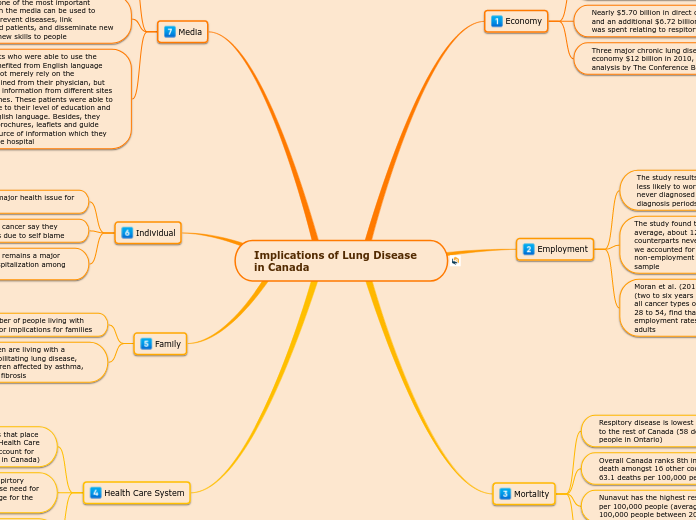Implications of Lung Disease in Canada
Economy
Almost 6.5% of total health care cost were related to respitory disease (not including lung cancer)
Nearly $5.70 billion in direct cost of healthcare and an additional $6.72 billion in indirect costs was spent relating to respitory disease
Three major chronic lung diseases cost Canada’s economy $12 billion in 2010, according to an analysis by The Conference Board of Canada
Employment
The study results show that cancer survivors are less likely to work compared with individuals never diagnosed with cancer in all three post-diagnosis periods
The study found that cancer survivors earn, on average, about 12% less in T+1 than their counterparts never diagnosed with cancer when we accounted for transitions from employment to non-employment by including zero earners in the sample
Moran et al. (2011), who study the long-term (two to six years after the diagnosis) effects of all cancer types on employment of workers aged 28 to 54, find that cancer survivors have lower employment rates than other similarly aged adults
Mortality
Respitory disease is lowest in Ontario compared to the rest of Canada (58 deaths per 100,000 people in Ontario)
Overall Canada ranks 8th in respitory related death amongst 16 other coountries (average of 63.1 deaths per 100,000 people)
Nunavut has the highest respitory related deaths per 100,000 people (average of 303.3 deaths per 100,000 people between 2009-2011)
Overall the Canadian territories have the highest amount of respitory related deaths compared to the other Canadian povinces. Yukon had an average of 100.5 deaths per 100,000 people and N.W.T had 103.1 deaths per 100,000 people between 2009-2011.
Media
The media as a source of information about cancer especially lung cancer could make substantial contribution to help physicians and patients in terms of prevention, treatment and follow up
Public health is one of the most important contexts in which the media can be used to inform people, prevent diseases, link professionals and patients, and disseminate new knowledge and new skills to people
Educated patients who were able to use the Internet and benefited from English language proficiency did not merely rely on the information obtained from their physician, but collected further information from different sites and search engines. These patients were able to analyze data due to their level of education and command of English language. Besides, they benefited from brochures, leaflets and guide booklets as a source of information which they received from the hospital
Individual
Lung cancer has become a major health issue for women
45% of Canadians with lung cancer say they delayed going to the doctors due to self blame
Overall, influenza/pneumonia remains a major contributor to deaths and hospitalization among the elderly
Family
With the increase number of people living with COPD it will cause major implications for families
13% of Canada’s children are living with a serious, chronic and debilitating lung disease, with over 487,000 children affected by asthma, tuberculosis, and cystic fibrosis
Health Care System
The top two leading respitory diseases that place the heaviest burden on the Canadian Health Care system are asthma and COPD (they account for over 50% of respirtory system deaths in Canada)
Canada is facing a wave of chronic respirtory disease, and the corresponding increase need for services will pose a significant challenge for the health care system
In 2004‐2005, respiratory disease had the second highest costs for acute inpatient care at $1.65 billion. That represented 9.5% of the total acute care inpatient budget
